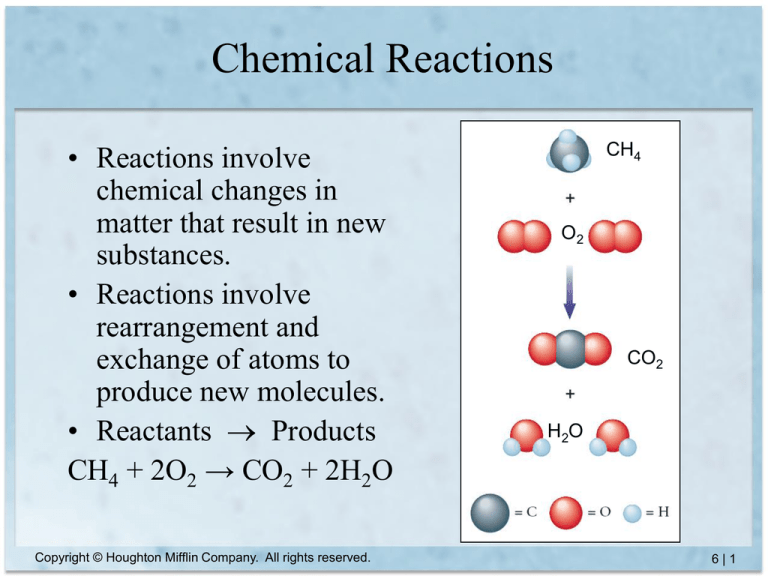
Chemical Reactions
• Reactions involve
chemical changes in
matter that result in new
substances.
• Reactions involve
rearrangement and
exchange of atoms to
produce new molecules.
• Reactants Products
CH4 + 2O2 → CO2 + 2H2O
Copyright © Houghton Mifflin Company. All rights reserved.
CH4
O2
CO2
H2O
6|1
Evidence of Chemical Reactions
• A chemical change occurs when new substances
are made.
• Visual clues (permanent):
– Color change, precipitate formation, gas bubbles,
flames, heat release, cooling, light
• Other clues:
– New odor, permanent new state
Copyright © Houghton Mifflin Company. All rights reserved.
6|2
Evidence of Chemical Reactions (cont.)
Copyright © Houghton Mifflin Company. All rights reserved.
6|3
Chemical Equations
• Shorthand way of describing a reaction
• Provides information about the reaction:
– Formulas of reactants and products
– States of reactants and products
– Relative numbers of reactant and product molecules
that are required
– CH4(g)+ 2O2(g) → CO2(g) + 2H2O(l)
– Can be used to determine weights of reactants used and
of products that can be made
Copyright © Houghton Mifflin Company. All rights reserved.
6|4
Symbols Used in Equations
• Symbols used after chemical formula to
indicate state:
– (g) = gas; (l) = liquid; (s) = solid
– (aq) = aqueous, dissolved in water
– e. g. NH3(aq) indicates ammonia dissolved in
water
Copyright © Houghton Mifflin Company. All rights reserved.
6|5
Conservation of Mass
• Matter cannot be created or destroyed.
• In a chemical reaction, all the atoms present
at the beginning are still present at the end.
• Therefore, the total mass cannot change.
Copyright © Houghton Mifflin Company. All rights reserved.
6|6
Combustion of Methane
• Methane gas burns to produce carbon dioxide gas
and liquid water
CH4(g) + O2(g) CO2(g) + H2O(l)
O
H
C
H H
H
+
O
O
C
+
O
H
H
O
1C+4H
+
2O
Copyright © Houghton Mifflin Company. All rights reserved.
1C+2O +2H+O
1C+2H+3O
6|7
Combustion of Methane Balanced
• To show a reaction obeys the Law of Conservation
of Mass, it must be balanced.
CH4(g) + 2 O2(g) CO2(g) + 2 H2O(l)
H
H
C
H
H
O
+
O
C
+
O
O
O
1C + 4H + 4O
Copyright © Houghton Mifflin Company. All rights reserved.
O
O
+
H
H
+
O
H
H
1C + 4H + 4O
6|8
Writing Equations
• Use proper formulas for each reactant and product.
• Proper equation should be balanced.
– Obey Law of Conservation of Mass.
– All elements on reactants side also on product side.
– Equal numbers of atoms of each element on reactant
side as on product side.
• Balanced equations show the relationship between
the relative numbers of molecules of reactants
and products.
– Can be used to determine mass relationships
Copyright © Houghton Mifflin Company. All rights reserved.
6|9
Balancing Chemical Equations
• If the equation is in words, write the formulas for the
reactants and products (include physical states).
• Balance the equation by counting the atoms on both
sides of the equation and changing the coefficients as
needed. Never change the subscripts!
• This is done by trial and error. Start with the most
complicated compound first.
• The best balanced equation is the one with the
smallest integer coefficients (not fractions).
Copyright © Houghton Mifflin Company. All rights reserved.
6 | 10
Balance the following equations:
• Solid potassium reacts with gaseous nitrogen to form solid
potassium nitride.
• C3H8(g) + O2(g) → CO2(g) + H2O(l)
• CuSO4(aq) + KI(s) → CuI(s) + I2(s) + K2SO4(aq)
Copyright © Houghton Mifflin Company. All rights reserved.
6 | 11

